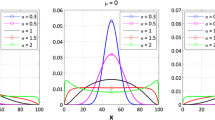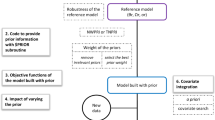Abstract
Deriving a population pharmacokinetic model from real data is always associated with numerous assumptions. Violations of these assumptions, especially if undetected, may lead to inappropriate conclusions being made from the analysis. Routinely, only a few of the assumptions are explicitly stated and justified in the reporting of a population model. Here, we attempt to be exhaustive in the presentation of the assumptions made in the course of an analysis of moxonidine pharmacokinetics. The different ways that assumptions were justified, through experience, graphical examination, or additional modeling, are outlined. Models for relaxing assumptions regarding the covariate and statistical submodels, not previously reported in the area of population pharmacokinetic modeling, are also described.
Similar content being viewed by others
REFERENCES
L. Aarons, L. P. Balant, M. Danhof, M. Gex-Fabry, U. A. Gundert-Remy, M. O. Karlsson, F. Mentré, F. Rombout, M. Rowland, J.-L. Steimer, and S. Vozeh (eds.). The Population Approach: Measuring and Managing Variability in Response, Concentration and Dose, European Commission, Brussels, 1997.
K. Fattinger, S. Vozeh, and H. R. Ha. Population pharmacokinetics of quinidine. Br. J. Clin. Pharmacol. 31:279–286 (1991).
D. J. Nichols, P. A. Milligan, E. N. Jonsson, et al. Application of population analysis in phase I/II clinical drug development. In L. Aarons et al. (eds.) The Population Approach: Measuring and Managing Variability in Response, Concentration and Dose, European Commission, Brussels, 1997.
M. D. Hale. Using population pharmacokinetics for planning a randomized concentration-controlled trial with a binary response. In L. Aarons et al. (eds.) The Population Approach: Measuring and Managing Variability in Response, Concentration and Dose, European Commission, Brussels, 1997.
M. Hale, R. Gillespie, S. Gupta, B. Tuk, and N. H. G. Holford. Clinical trial simulation as a tool for increased drug development efficiency. Appl. Clin. Trials 5:35–40 (1996).
D. W. Cockroft and M. H. Gault. Prediction of creatinine clearance from serum creatinine. Nephron 16:31–41 (1976).
J. W. Mandema, D. Verotta, and L. B. Sheiner. Building population pharmacokinetic-pharmacodynamic models. I. Models for covariate effects. J. Pharmacokin. Biopharm. 20:511–528 (1992).
R. Bruno, N. Vivier, G. Montay, A. Le Liboux, L. K. Powe, J.-C. Delumeau, and G. R. Rhodes. Population pharmacokinetics of riluzole in patients with amyotrophic lateral sclerosis. Clin. Pharmacol. Ther. 62:518–526 (1997).
V. Schmith, J. Fiedler-Kelly, M. Abou-Donia, C. S. Huffman, and T. H. Grasela. Population pharmacodynamics of doxacurium. Clin. Pharmacol. Ther. 52:528–536 (1992).
P. Burtin, E. V. Jacz-Aigrain, P. Girard, R. Lenclen, J-F. Magny, P. Betremeiux, C. Tehiry, L. Desplanques, and P. Mussat. Population pharmacokinetics of midazolam in neonates. Clin. Pharmacol. Ther. 56:615–625 (1994).
M. O. Karlsson and L. B. Sheiner. The importance of modelling interoccasion variability in population pharmacokinetic analyses. J. Pharmacokin. Biopharm. 21:735–750 (1993).
A. Mallet, F. Mentré, J. Gilles, et al. Handling covariates in population pharmacokinetics, with application to Gentamicin. Biomed. Meas. Inform. Contr. 2:138–146 (1988).
S. L. Beal and L. B. Sheiner (eds.). NONMEM Users Guides, NONMEM project group, University of California, San Fransisco, CA, 1992.
G. A. F. Seber and C. J. Wild. Nonlinear Regression, Wiley, New York, 1989.
M. O. Karlsson, S. L. Beal, and L. B. Sheiner. Three new residual error models for population PK/PD analyses. J. Pharmacokin. Biopharm. 23:651–672 (1995).
M. Davidian and D. M. Giltinan. Some general estimation methods for nonlinear mixed-effects models. J. Biopharm. Stat. 3:23–55 (1993).
D. Ruppert, N. Cressie, and R. J. Carroll. A transformation/weighting model estimating Michaelis-Menten parameters. Biometrics 45:637–656 (1989).
A. Mallet. A maximum likelihood estimation method for random coefficient regression models. Biometrika 73:645–656 (1986).
E. N. Jonsson, Janet R. Wade, G. Almqvist, and M. O. Karlsson. Discrimination between rival dosing histories. Pharm. Res. 14:984–991 (1997).
MathSoft. S-PLUS User's Manual, Version 3.4, Data Analysis Products Division, MathSoft, Seattle, 1997.
M. K. Al-Banna, A. W. Kelman, and B. Whiting. Experimental design and efficient parameter estimation in population pharmacokinetics. J. Pharmacokin. Biopharm. 18:347–360 (1990).
E. I. Ette, C. A. Howie, A. W. Kelman, and B. Whiting. Experimental design and efficient parameter estimation in preclinical pharmacokinetic studies. Pharm. Res. 12:729–737 (1995).
L. B. Sheiner and S. L. Beal. Evaluation of methods for estimating population pharmacokinetic parameters. I. Michaelis-Menten model: Routine clinical pharmacokinetic data. J. Pharmacokin. Biopharm. 8:553–571 (1980).
L. B. Sheiner and S. L. Beal. Evaluation of methods for estimating population pharmacokinetic parameters II. Biexponential model; experimental pharmacokinetic data. J. Pharmacokin. Biopharm. 9 (1981).
L. B. Sheiner and S. L. Beal. Evaluation of methods for estimating population pharmacokinetic parameters: III. Monoexponential model; routine clinical pharmacokinetic data. J. Pharmacokin. Biopharm. 11:303–319 (1983).
J. E. Bennet and J. C. Wakefield. A comparison of a Bayesian population method with two methods as implemented in commercially available software. J. Pharmacokin. Biopharm. 24:403–432 (1996).
P. Girard, L. B. Sheiner, H. Kastrissios, and T. F. Blaschke. Do we need full compliance data for population pharmacokinetic analysis. J. Pharmacokin. Biopharm. 24:265–282 (1996).
N. Wang and M. Davidian. A note on covariate measurement error in nonlinear mixed effects models. Biometrika 83:801–812 (1996).
N. Draper and H. Smith. Applied regression analysis, 2nd ed., Wiley, 1981, pp. 122–125.
J. W. Mandema. Population pharmacokinetics and pharmacodynamics. In P. G. Welling and F. L. S. Tse (eds.), Pharmacokinetics, Marcel Dekker, New York, 1995.
D. Trenk, F. Wagner, E. Jahnchen, and V. Plantiz. Pharmacokinetics of moxonidine after single and repeated doses in healthy volunteers. J. Clin. Pharmacol. 27:988–993 (1987).
W. S. Cleveland, Visualizing Data, Hobart Press, Summit, NJ, 1993.
J. W. Mandema, D. Verotta, and L. B. Sheiner. Advanced Methods of Pharmacokinetic and Pharmacodynamic Systems Analysis, Vol. 2, Chap. “Building population pharmacokinetic-pharmacodynamic models,” Plenum Press, 1993.
E. J. Antal, T. H. Grasela, and R. B. Smith. An evaluation of population pharmacokinetics in therapeutic trials. Part III. Prospective data collection versus retrospective data assembly. Clin. Pharmacol. Ther. 46:552–559 (1989).
S. L. Beal. Population pharmacokinetic data and parameter estimation based on their first two statistical moments. Drug Metab. Rev. 15(1&2):173–193 (1984).
J. R. Wade, S. L. Beal, and N. C. Sambol. Interaction between structural, statistical and covariate models in population pharmacokinetic analysis. J. Pharmacokin. Biopharm. 22:165–177 (1994).
E. I. Ette and T. M. Ludden. Population pharmacokinetic modelling: The importance of informative graphics. Pharm. Res. 12:1845–1855, (1995).
N. Taright, F. Mentré, and A. Mallet. Non-stationarity of kinetic parameters in multi-occasion designs. PAGE conference, Glasgow, June 1997. (Abstract on internet address http://www.gla.ac.uk/Acad/MedTer/Page97).
K. E. Fattinger and D. Verotta. A nonparametric subject-specific population method for deconvolution: II. External validation. J. Pharmacokin. Biopharm. 23:611–634 (1995).
M. O. Karlsson, R. E. Port, M. J. Ratain, and L. B. Sheiner. A population-model for the leukopenic effect of etoposide. Clin. Pharmacol. Ther. 57:325–334 (1995).
L. Aarons, L. P. Balant, F. Mentré, et al. Practical experience and issues in designing and performing population pharmacokinetic/pharmacodynamic studies. Eur. J. Clin. Pharmacol. 49:251–254 (1996).
W. Kirch, H. J. Hutt, and V. Plantiz. The influence of renal function on clinical pharmacokinetics of moxonidine. Clin. Pharmacokin. 15:245–253 (1988).
Author information
Authors and Affiliations
Rights and permissions
About this article
Cite this article
Karlsson, M.O., Jonsson, E.N., Wiltse, C.G. et al. Assumption Testing in Population Pharmacokinetic Models: Illustrated with an Analysis of Moxonidine Data from Congestive Heart Failure Patients. J Pharmacokinet Pharmacodyn 26, 207–246 (1998). https://doi.org/10.1023/A:1020561807903
Published:
Issue Date:
DOI: https://doi.org/10.1023/A:1020561807903




